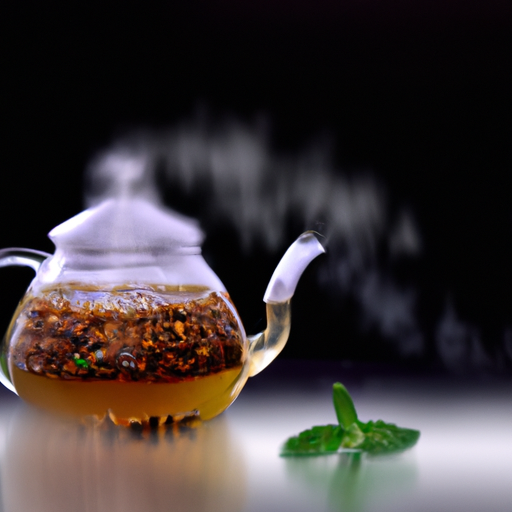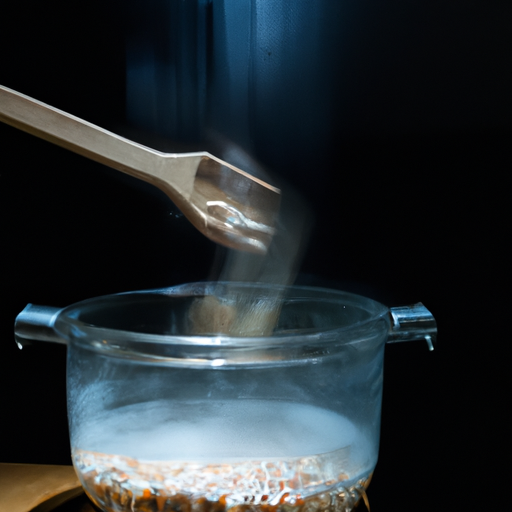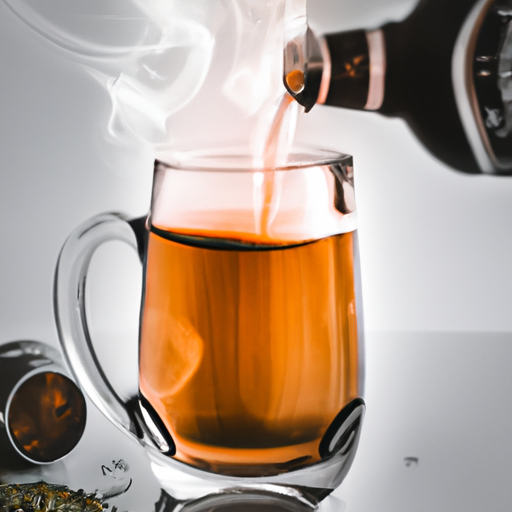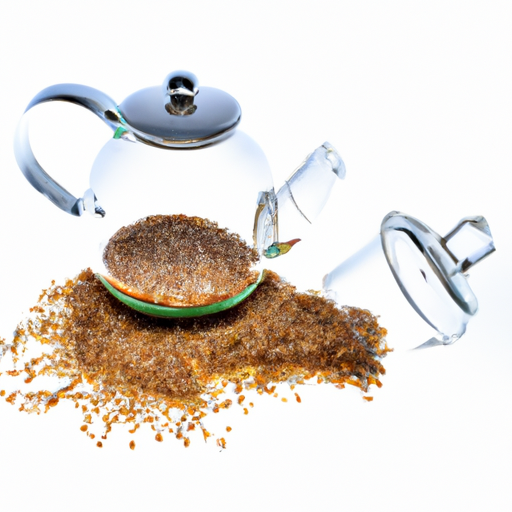As a tea enthusiast constantly on the lookout for unique flavors, I came across the delightful world of barley tea. This beverage, crafted from toasted barley grains, is a popular choice across several East Asian nations like Japan, Korea, and China. Beyond its pleasant and refreshing taste, barley tea offers numerous health advantages, including aiding digestion and enhancing relaxation.
In this article, I will be sharing with you how to prepare barley tea in the comfort of your own home. It’s a straightforward process that requires only a few ingredients and minimal effort. Whether you’re an avid tea drinker or someone who’s looking to try something new, I guarantee that barley tea will become a new favorite in your tea collection.
So, let’s get started on brewing our own batch of this delightful tea!
Key Takeaways
- Roasting the barley grains before steeping enhances the flavor and aroma of the tea.
- Soaking and rinsing the barley grains before roasting is important for the best results.
- Straining the barley tea is essential to remove any sediment or particles.
- Barley tea can be served hot or cold and can be flavored with honey, lemon, or various herbs.
Gathering Ingredients
Gatherin’ up the barley and water is the first step to brewin’ a delicious cup of barley tea. When it comes to barley, there are several varieties to choose from. For instance, Hulled barley is the most common type used for tea in Asian countries like Japan and Korea. Meanwhile, Pearl barley is more widely used in Western countries. Exploring barley varieties is a great way to understand the different flavors and textures that they bring to the tea.
Apart from exploring barley varieties, it’s also essential to understand the cultural significance of barley tea. In Korea, barley tea is served cold during hot summer days, while in Japan, it’s served hot throughout the year. Barley tea is also a popular drink in other Asian countries like China and Taiwan, where it’s known for its refreshing taste and health benefits.
Now that you’ve gathered your barley, it’s time to roast the grains. By roasting barley, you enhance the flavor and aroma of the tea. Roasting also helps to remove any excess moisture from the grains, making it easier to brew a delicious cup of tea.
Roasting Barley Grains
So, here’s what I’ve learned about roasting barley grains for making barley tea. Firstly, preparing the grains is a crucial step that involves cleaning and washing them thoroughly.
Once that’s done, the grains are roasted in a pan or oven until they turn golden brown, releasing a nutty aroma. This process enhances the flavor and aroma of the tea, making it a perfect beverage to enjoy any time of the day.
Preparing the grains
First, you’ll need to rinse the barley grains thoroughly under cold water. This step is important to remove any dirt or debris that may be present on the grains.
After rinsing, you can soak the grains for a few hours to help soften them and reduce the cooking time.
Choosing the right grains is also crucial in preparing barley tea. Different types of barley grains can have varying flavors and textures. Additionally, the roasting technique used can greatly impact the flavor of the tea.
Soaking and rinsing the grains before roasting is important to ensure that they are clean and evenly roasted. With the grains properly prepared, you can now move on to the roasting process in a pan or oven.
Roasting in a pan or oven
To achieve a rich and complex flavor profile, it’s essential to carefully roast the grains in either a pan or oven. When roasting barley grains, there are two methods to choose from: pan roasting and oven roasting.
Pan roasting involves heating a dry pan over medium heat and adding the barley grains. Stirring constantly, the grains will slowly darken and release a nutty aroma.
Oven roasting is done by spreading the grains on a baking sheet and heating in a preheated oven at 350°F for about 15-20 minutes, stirring occasionally. The grains will turn a deep golden brown color and have a toasty flavor. Flavor profile differences between the two methods are minimal, but some prefer oven roasting for larger batches and pan roasting for smaller quantities.
To continue with the process, I then move on to boiling water and adding barley grains.
Boiling Water and Adding Barley Grains
Once the water’s boiling, simply add the barley grains and let them steep for a few minutes. This is one of the most traditional and simple ways to prepare barley tea. While there are alternative brewing methods, boiling the barley grains in water is the most straightforward way to make a refreshing cup of tea.
Boiling water and adding barley grains is a great way to bring out the natural flavors and benefits of using roasted barley. Roasting the barley in a pan or oven before brewing adds a nutty and toasty flavor that many people enjoy. It also enhances the health benefits of barley, such as reducing cholesterol levels and promoting healthy digestion.
After steeping the barley grains for a few minutes, it’s time to strain the tea to remove any solids. This can be done using a tea strainer or a cheesecloth. The resulting liquid will be a light brown color and have a slightly nutty taste.
This tea can be enjoyed hot or cold and can be sweetened with honey or sugar, depending on your preference. Moving on to the next step, steeping and straining the tea will further enhance the flavor and health benefits of your barley tea.
Steeping and Straining
Now that I’ve boiled the water and added the barley grains, it’s time to let the tea steep.
Steeping allows the grains to release their flavor and nutrients into the water.
After steeping, the grains need to be strained out before enjoying a refreshing cup of barley tea.
Allowing the tea to steep
Ready to savor the rich flavor of barley tea? Let the tea steep for at least 10 minutes, allowing the water to fully extract the nutty notes from the roasted barley. Steeping is an essential step in making barley tea as it infuses the water with the barley’s flavors and nutrients. The longer you steep the tea, the stronger the flavor will be. Moreover, steeping also enhances the health benefits of the tea.
Benefits of steeping include enhancing the flavor and aroma of the tea, as well as extracting its nutrients. Different steeping techniques can also have an impact on the flavor profile of the tea. For example, some people prefer a quick steep for a lighter, milder flavor, while others opt for a longer steep for a stronger, bolder taste. It’s important to find the right steeping method that suits your preferences. Once the tea has steeped for the desired amount of time, it’s time to move on to the next step – straining the grains to obtain the clear liquid.
Now that the tea has fully steeped, it’s time to strain the grains to separate them from the liquid. Straining the barley tea is essential to remove any sediment or particles that may have been left behind during the steeping process. This helps to ensure that the tea is smooth and free of any debris. There are several methods for straining the tea, such as using a fine mesh strainer or a cheesecloth. Choose the method that works best for you and enjoy your freshly brewed barley tea!
Straining the grains
To obtain a clear and smooth liquid, it’s essential to strain the grains from the brewed mixture. Here’s how I strain my barley tea for the best results:
- Grab a large bowl and place a cheesecloth over it.
- Slowly pour the brewed barley tea through the cheesecloth, allowing the liquid to strain into the bowl.
- Once the bulk of the liquid has been strained, gather the corners of the cheesecloth and gently squeeze out any remaining liquid.
- Discard the barley grains in the cheesecloth or save them for other recipes such as soups or stews.
Using a cheesecloth to strain the barley tea not only separates the grain from the liquid but also helps to remove any impurities that may have been present during the brewing process.
Don’t forget to save the barley grains for later use, as they can add a tasty and nutritious twist to your meals. With the grains removed, it’s time to move on to the optional flavor additions for a personalized touch.
Optional Flavor Additions
Now that we know how to steep and strain barley tea, let’s talk about ways to add flavor to it.
Personally, I enjoy adding a spoonful of honey to my tea to give it a touch of sweetness. Another option is to squeeze some fresh lemon juice into the tea for a tangy twist. Additionally, adding fresh mint leaves or other herbs can give the tea a refreshing and aromatic flavor.
Experiment with different flavor combinations to find your favorite!
Adding honey or lemon
If you’re feeling a little under the weather, adding a spoonful of honey or a squeeze of lemon to your barley tea can give it a soothing boost. Both honey and lemon are considered natural remedies for coughs and colds. Honey has antibacterial properties that can help fight off infections while lemon is rich in vitamin C which can boost the immune system.
When adding sweeteners to barley tea, it’s important to consider the flavor combinations that work best. In a table below, I’ve outlined some of the different combinations of barley tea with honey and lemon to help you choose the best one for your taste buds. While both honey and lemon are great options, it ultimately comes down to personal preference.
| Barley Tea with Sweeteners | Honey | Lemon |
|---|---|---|
| Classic | 1 tbsp honey | 1 wedge lemon |
| Sweet and Sour | 1 tbsp honey | 2 wedges lemon |
| Earthy and Sweet | 2 tbsp honey | 1 wedge lemon |
| Citrusy and Floral | 1 tbsp honey | 1 tbsp lemon juice |
Adding mint or other herbs to your barley tea can provide an additional layer of flavor.
Adding mint or other herbs
Adding mint or other herbs can take your barley tea to the next level, creating a burst of fresh and invigorating flavors that will make your taste buds dance with joy. Mint is a natural pairing for barley tea, as it adds a cooling and refreshing element that complements the nutty and earthy flavor of the tea.
Other herbs, such as lavender, rosemary, or chamomile, also work well with barley tea and can create unique herbal tea blends that are both delicious and healthful.
To make a mint barley tea, simply add a handful of fresh mint leaves to the steeping barley tea and let it infuse for a few minutes. The longer you steep the tea, the stronger the mint flavor will be. You can also experiment with different ratios of barley to mint, depending on your taste preferences.
For a more complex herbal blend, try adding other herbs to the mix and see what works best for you.
Now that you know how to add some extra flavor to your barley tea with mint and other herbs, it’s time to learn about serving and storing this delicious beverage.
Serving and Storing
To keep your barley tea fresh and flavorful, store it in a sealed container in the refrigerator. Here are some storing tips and serving suggestions to ensure that your barley tea is enjoyable every time you drink it.
-
Storing Tips:
-
Store your barley tea in a sealed container in the refrigerator to prevent it from going stale.
-
Ensure that the container is clean and dry before storing your tea to prevent contamination.
-
Use the tea within a few days of preparation for the best taste.
-
Serving Suggestions:
-
You can serve barley tea hot or cold, depending on your preference.
-
Add a slice of lemon or lime to your iced barley tea for a refreshing twist.
-
You can also sweeten your tea with honey, sugar, or stevia if you like.
By following these storing tips and serving suggestions, you can make sure that your barley tea is always fresh and delicious.
Now that you know how to store and serve your barley tea, let’s move on to the next section about the variations of barley tea.
Variations of Barley Tea
Now, let’s explore different ways you can jazz up your cup of this refreshing beverage. Remember, variety is the spice of life!
When it comes to barley tea variations, there are two main categories: traditional and modern. Traditional barley tea consists of only barley grains and water, while modern versions often include additional ingredients like honey, lemon, or ginger to enhance the flavor.
Regional differences also play a role in the types of barley tea variations available. In Korea, roasted barley tea is a popular summer drink that is often served cold. In Japan, mugicha is a type of barley tea made by roasting the barley grains before steeping them in hot water. This results in a nutty and slightly sweet flavor that is enjoyed both hot and cold.
Despite the variations in flavor and preparation, the health benefits of barley tea remain consistent. Its high antioxidant content can help reduce inflammation and the risk of chronic diseases such as heart disease and diabetes. Plus, its caffeine-free nature makes it a great alternative to coffee or black tea for those looking to reduce their caffeine intake.
So go ahead, try out a new variation of barley tea and reap the health benefits at the same time!
Health Benefits of Barley Tea
The health benefits of barley tea are consistent. It has high levels of antioxidants that can help reduce inflammation and the risk of chronic diseases such as heart disease and diabetes. Barley tea’s antioxidant properties are linked to the presence of phenolic compounds, which have beneficial effects on health. These compounds can help prevent damage to cells and reduce the risk of chronic diseases.
In addition to its antioxidant properties, barley tea may also play a potential role in weight loss. Studies have shown that the polyphenols found in barley tea can promote weight loss by reducing the absorption of dietary fat and carbohydrates. This means that drinking barley tea regularly can help you maintain a healthy weight and reduce your risk of obesity-related diseases.
Overall, barley tea is a healthy and refreshing beverage that offers numerous health benefits. Its antioxidant properties and potential role in weight loss make it an excellent addition to any diet. So, why not try a cup of barley tea the next time you’re looking for a healthy drink option?
Frequently Asked Questions
What is the origin of barley tea?
Barley tea, like many other traditional drinks, is a cultural staple that has been consumed for centuries. Its origin can be traced back to ancient China, where it was used for medicinal purposes.
Over time, the tea spread to other parts of Asia, such as Japan and Korea, where it became a popular beverage. Today, barley tea is enjoyed for its unique flavor and health benefits.
In Japan, it is known as ‘mugicha,’and is often served cold in the summer months. The cultural significance of barley tea lies in its ability to bring people together, whether it’s for a relaxing afternoon break or a shared meal.
Its rich history and versatility make it a beloved drink that is sure to be enjoyed for generations to come.
Can barley tea be made with other types of grain?
Yes, barley tea can be made with other types of grain, such as corn, rice, and wheat. However, each grain will have a slightly different taste and may require different preparation methods.
Barley tea is a popular beverage in Asia, known for its health benefits including aiding digestion and improving circulation. It’s also low in calories and caffeine-free.
Alternative grains for tea can provide similar benefits and can be a great option for those who are gluten intolerant or looking for a new flavor profile. Experiment with different grains to find the one that best suits your taste preferences and health needs.
How long can barley tea be stored in the refrigerator?
When it comes to storing barley tea, it’s important to consider shelf life and preservation techniques.
Generally speaking, barley tea can be stored in the refrigerator for up to a week. However, if you want to extend its shelf life, you can freeze it for up to three months.
As for recipe variations and flavor combinations, the possibilities are endless. Some people like to add honey or lemon for sweetness, while others prefer to mix in other grains like rice or corn.
Regardless of how you prepare your barley tea, just make sure to store it properly to ensure it stays fresh and delicious.
Does barley tea have any caffeine content?
Oh, the irony of it all! A delicious and comforting drink that won’t keep you up at night. Yes, that’s right, barley tea is caffeine-free!
So, if you’re looking for a warm beverage to help you unwind after a long day, this might be just the ticket. But don’t let the lack of caffeine fool you, there are plenty of health benefits to be gained from drinking barley tea. From reducing inflammation to aiding in digestion, this brew has been used for centuries in traditional medicine.
And don’t worry about brewing it, it’s as simple as steeping the grains in boiling water and letting it sit for a few minutes. So go ahead, brew up a batch and enjoy all the goodness that barley tea has to offer.
Can barley tea be served cold or only hot?
When it comes to serving barley tea, the answer is simple: it can be served either cold or hot, depending on personal preference. Personally, I enjoy it both ways.
In terms of health benefits, barley tea is a great alternative to coffee as it contains no caffeine and has a slightly sweet and nutty flavor. It’s also packed with antioxidants, which can help reduce inflammation and improve overall health.
Whether you choose to enjoy it hot or cold, barley tea is a delicious and healthy beverage option.
Conclusion
In conclusion, preparing barley tea is a simple process that can provide numerous health benefits. Did you know that barley tea is the most popular non-alcoholic drink in Japan? It’s consumed by over 80% of the population and is often served in restaurants and homes.
This interesting statistic highlights the popularity and cultural significance of barley tea in Japan. Aside from its popularity, barley tea is also a great source of antioxidants and has been shown to improve digestion and reduce inflammation.
Adding flavorings such as lemon or honey can enhance the taste of the tea, making it an enjoyable beverage option. So why not give barley tea a try and experience its delicious taste and health benefits for yourself?










